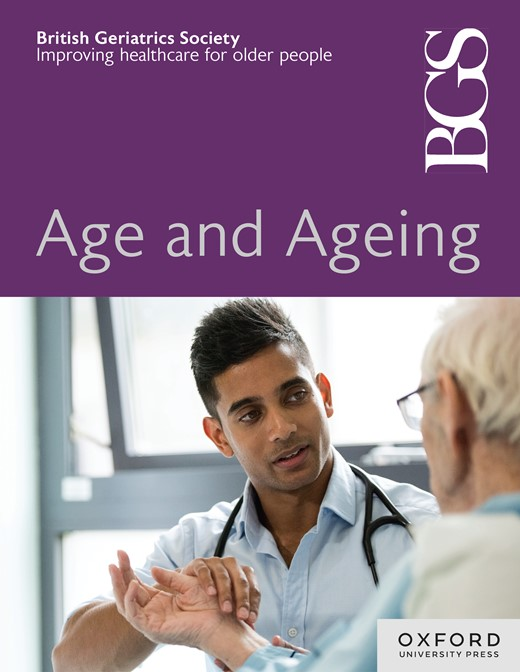Early Mobilisation Post-Thrombolysis is Safe and Improves Outcomes in Mild-Moderate Acute-Stroke Patients
IF 7.1
2区 医学
Q1 GERIATRICS & GERONTOLOGY
引用次数: 0
Abstract
Background Thrombolysis (tPA) is the delivery of a clot-lysing agent used in acute ischemic stroke, typically followed by ≥24-hour bed rest. This study aimed to compare the safety and effectiveness of early mobilisation (≤24 hours post-tPA) versus ≥24-hour bed rest in patients with mild-moderate stroke. Methods A literature review was conducted leading to the development of an early mobilisation protocol post-tPA. Retrospective (January-July 2023: pre-early mobilisation protocol) and prospective (July 2023-April 2024: post-early mobilisation protocol) data were analysed. Baseline demographics and outcomes were compared between the two groups. Primary outcome was physical function (Modified Rankin Scale (mRS) at hospital discharge. Secondary outcomes included adverse effects, length of stay (LOS) and discharge destination. Results 11 patients met the criteria for early mobilisation in both groups. There were no significant differences in age, the National Institutes of Health Stroke Scale (NIHSS) pre-tPA and mRS at baseline between the two groups (p>0.05). 8 patients in the early mobilisation protocol were male (72.73%), the median (IQR) age was 61 (54-78) years, and NIHSS was 6 (3-8) pre-tPA and 1 (0-2) post-tPA. Patients had a median (IQR) mRS score of 0 (0-0) pre-stroke and time to early mobilisation was 12 (12-17) hours. Patients in the early mobilisation group had significantly lower mRS on discharge (p=0.007), shorter LOS (Median (IQR) 5 (4-7) days, P=0.13) and higher rates of discharge directly home compared to those mobilised post ≥24-hour bed rest. No adverse effects of early mobilisation occurred. Conclusion Compared with 24-hour bed rest, early mobilisation for mild-moderate stroke patients was safe and associated with significantly better physical function.溶栓后早期活动既安全又能改善轻中度急性中风患者的预后
背景 溶栓(tPA)是一种用于急性缺血性脑卒中的血栓溶解剂,通常需要≥24 小时的卧床休息。本研究旨在比较轻中度脑卒中患者早期活动(tPA 后≤24 小时)与≥24 小时卧床休息的安全性和有效性。方法 通过文献综述,制定了 tPA 术后早期活动方案。分析了回顾性(2023 年 1 月至 7 月:早期康复方案前)和前瞻性(2023 年 7 月至 2024 年 4 月:早期康复方案后)数据。比较了两组的基线人口统计学特征和结果。主要结果是出院时的身体功能(改良Rankin量表(mRS))。次要结果包括不良反应、住院时间(LOS)和出院目的地。结果 两组中均有11名患者符合早期康复标准。两组患者在年龄、tPA 前美国国立卫生研究院卒中量表(NIHSS)和基线 mRS 方面无明显差异(p>0.05)。早期动员方案的 8 名患者均为男性(72.73%),年龄中位数(IQR)为 61(54-78)岁,TPA 前 NIHSS 为 6(3-8),TPA 后为 1(0-2)。患者卒中前的 mRS 评分中位数(IQR)为 0(0-0),早期活动时间为 12(12-17)小时。与≥24小时卧床休息后动员的患者相比,早期动员组患者出院时的mRS评分明显较低(P=0.007),LOS时间较短(中位数(IQR)为5(4-7)天,P=0.13),直接出院回家的比例较高。早期康复没有不良反应。结论 与 24 小时卧床休息相比,对轻中度卒中患者进行早期康复是安全的,而且能显著改善患者的身体功能。
本文章由计算机程序翻译,如有差异,请以英文原文为准。
求助全文
约1分钟内获得全文
求助全文
来源期刊

Age and ageing
医学-老年医学
CiteScore
9.20
自引率
6.00%
发文量
796
审稿时长
4-8 weeks
期刊介绍:
Age and Ageing is an international journal publishing refereed original articles and commissioned reviews on geriatric medicine and gerontology. Its range includes research on ageing and clinical, epidemiological, and psychological aspects of later life.
 求助内容:
求助内容: 应助结果提醒方式:
应助结果提醒方式:


